Articles
- Page Path
- HOME > Restor Dent Endod > Volume 37(3); 2012 > Article
- Research Article The reduction methods of operator's radiation dose for portable dental X-ray machines
- Jeong-Yeon Cho, Won-Jeong Han
-
2012;37(3):-164.
DOI: https://doi.org/10.5395/rde.2012.37.3.160
Published online: August 29, 2012
Department of Oral & Maxillofacial Radiology, Dankook University College of Dentistry, Cheonan, Korea.
- Correspondence to Won-Jeong Han, DDS, MSD, PhD. Associate Professor, Department of Oral & Maxillofacial Radiology, Dankook University College of Dentistry, 119 Dandae-ro, Dongnam-gu, Cheonan, Korea 330-714. TEL, +82-41-550-1922; FAX, +82-41-556-7127; wjhan@dankook.ac.kr
©Copyights 2012. The Korean Academy of Conservative Dentistry.
This is an Open Access article distributed under the terms of the Creative Commons Attribution Non-Commercial License (http://creativecommons.org/licenses/by-nc/3.0/) which permits unrestricted non-commercial use, distribution, and reproduction in any medium, provided the original work is properly cited.
- 4,602 Views
- 27 Download
- 16 Crossref
Abstract
-
Objectives This study was aimed to investigate the methods to reduce operator's radiation dose when taking intraoral radiographs with portable dental X-ray machines.
-
Materials and Methods Two kinds of portable dental X-ray machines (DX3000, Dexcowin and Rextar, Posdion) were used. Operator's radiation dose was measured with an 1,800 cc ionization chamber (RadCal Corp.) at the hand level of X-ray tubehead and at the operator's chest and waist levels with and without the backscatter shield. The operator's radiation dose at the hand level was measured with and without lead gloves and with long and short cones.
-
Results The backscatter shield reduced operator's radiation dose at the hand level of X-ray tubehead to 23 - 32%, the lead gloves to 26 - 31%, and long cone to 48 - 52%. And the backscatter shield reduced operator's radiation dose at the operator's chest and waist levels to 0.1 - 37%.
-
Conclusions When portable dental X-ray systems are used, it is recommended to select X-ray machine attached with a backscatter shield and a long cone and to wear the lead gloves.
Introduction
Materials and Methods
1) Operator's radiation dose measurement with the use of the backscatter shield
(1) At the operator's hands level
(2) At the operator's chest and waist levels
2) Operator's radiation dose measurement with the use of the lead gloves
3) Operator's radiation dose measurements according to the cone length of tubehead
Results
Discussion
Conclusions
-
This research was supported by a grant (11172KFDA528) from Korea Food and Drug Administration in 2011.
- 1. Coy JD. Use of lightweight X-ray machine and processor during Riverine medical readiness training exercise on the Amazon River. Mil Med 1991;156:623-628.ArticlePubMed
- 2. Van Dis ML, Miles DA, Parks ET, Razmus TF. Information yield from a hand-held dental x-ray unit. Oral Surg Oral Med Oral Pathol 1993;76:381-385.ArticlePubMed
- 3. Coy J. Hand-held dental X-ray (HDX) with medical collimator: use in casualty radiology. Mil Med 1996;161:428-431.ArticlePubMed
- 4. Coy J, Vandre RH, Davidson WR. Use of the hand-held dental X-ray machine during joint operation, NATO exercise Display Determination-92. Mil Med 1997;162:575-577.ArticlePubMed
- 5. Varghese S, Kimmel A, Radmer T, Bradley TG, Bahcall J. In vitro evaluation of the XR-15 portable x-ray unit for forensic odontology. J Forensic Odontostomatol 2004;22:5-8.PubMed
- 6. Charlton DG. Portable dental equipment: dental units and x-ray equipment. Gen Dent 2009;57:336-341.PubMed
- 7. Hermsen KP, Jaeger SS, Jaeger MA. Radiation safety for the NOMAD™ portable X-ray system in a temporary morgue setting. J Forensic Sci 2008;53:917-921.ArticlePubMed
- 8. Department of Licensing and regulatory affairs. Ionizing radiation rules, Part 9. Dental X-ray installations, R325.5396. Hand-held portable dental x-ray systems. Available from: http://www.michigan.gov/lara/0,4601,7-154-35299_28142_3579-46448--,00.html (updated 2012 July 30).
- 9. Ohio department of Health. Dental radiationgenerating equipment. Available from: http://www.odh.ohio.gov/~/media/ODH/ASSETS/Files/rules/final/37011-66/37011-66-06.ashx (updated 2012 July 30).
- 10. Washington state legislature. Radiation safety and diagnostic image quality standards for dental facilities, chapter 246-225A-085 Hand-held X-ray system. Available from: http://apps.leg.wa.gov/wac/default.aspx?cite=246-225A&full=true#246-225A-085 (updated 2012 July 30).
- 11. Kim EK. Leakage and scattered radiation from hand-held dental x-ray unit. Korean J Oral Maxillofac Radiol 2007;37:65-68.
- 12. National Institute of Food and Drug Safety Evaluation. Regulation for the safety management of diagnostic x-ray equipments. Available from: http://www.nifds.go.kr/nifds/01_about/about08.jsp?mode=view&article_no=4813&pager.offset=0&board_no=2 (updated 2012 July 30).
- 13. Danforth RA, Herschaft EE, Leonowich JA. Operator exposure to scatter radiation from a portable hand-held dental radiation emitting device (Aribex™ NOMAD™) while making 915 intraoral dental radiographs. J Forensic Sci 2009;54:415-421.ArticlePubMed
- 14. Goren AD, Bonvento M, Biernacki J, Colosi DC. Radiation exposure with the NOMAD™ portable X-ray system. Dentomaxillofac Radiol 2008;37:109-112.PubMed
- 15. Gray JE, Bailey ED, Ludlow JB. Dental staff doses with handheld dental intraoral x-ray units. Health Phys 2012;102:137-142.ArticlePubMed
- 16. White SC, Pharoah MJ. Oral radiology; principles and interpretation. 2009. 6th ed. St. Louis: Mosby-Year Book Inc.; p. 148-149.
- 17. Aribex, Inc. Aribex NOMAD™ dental portable x-ray system for intraoral radiographic imaging. User manual. 2006. Orem UT: Aribex, Inc.; Available from: http://aribex.com/portable-x-ray-machine/dental-x-raymachine/nomad-x-ray/nomad-safety (update 2012 Jan 30).
- 18. Pittayapat P, Oliveira-Santos C, Thevissen P, Michielsen K, Bergans N, Willems G, Debruyckere D, Jacobs R. Image quality assessment and medical physics evaluation of different portable dental X-ray units. Forensic Sci Int 2010;201:112-117.ArticlePubMed
REFERENCES
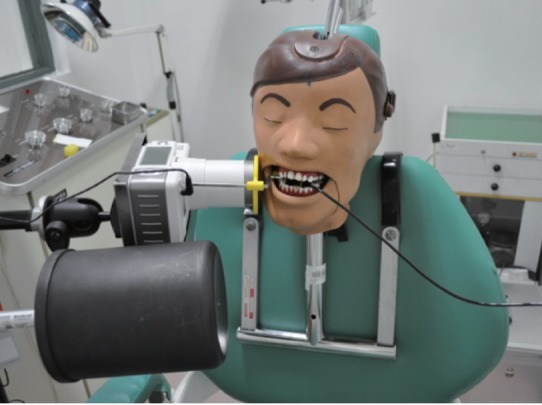
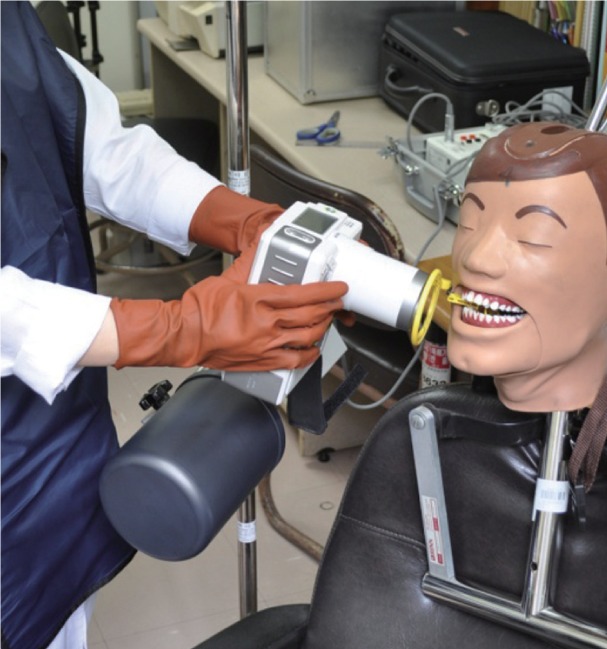
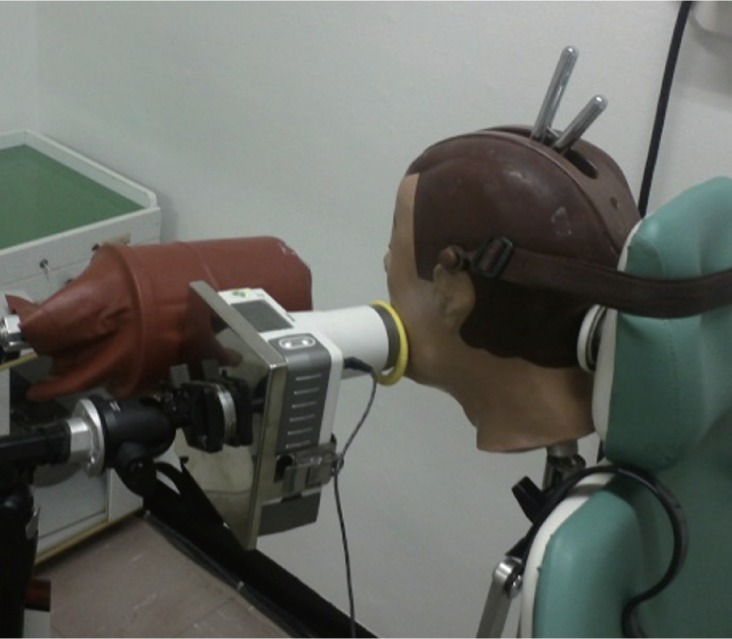

chest level, 130 cm height from floor; waist level, 70 cm height from floor.
*dose in µR means the leakage and scattered radiation dose and standard deviation measured by an 1,800 cc ionizing chamber.
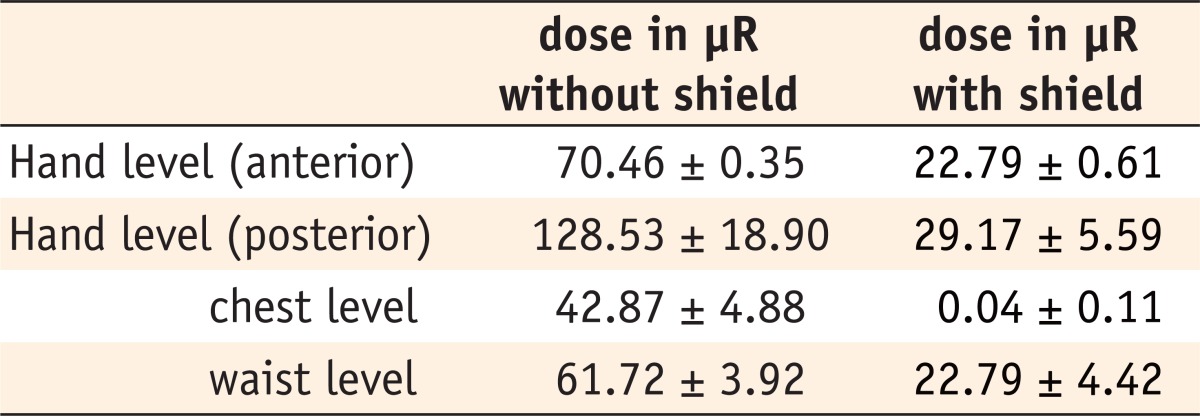
anterior teeth, lower anterior periapical radiography; posterior teeth, lower posterior periapical radiography.
*dose in µR means the average leakage and scattered radiation dose and standard deviation measured by an 1,800 cc ionizing chamber.

anterior teeth, lower anterior periapical radiography; posterior teeth, lower posterior periapical radiography.
*dose in µR means the average leakage and scattered radiation dose and standard deviation measured by 1,800 cc ionizing chamber.

Tables & Figures
REFERENCES
Citations

- Assessment of the Occupational Radiation Dose from a Handheld Portable X-ray Unit During Full-mouth Intraoral Dental Radiographs in the Dog and the Cat – A Pilot Study
Lenin A. Villamizar-Martinez, Jeannie Losey
Journal of Veterinary Dentistry.2024; 41(2): 106. CrossRef - Seguridad y protección radiológica con el uso de rayos X portátiles. Revisión de literatura
Francisco Javier Marichi-Rodríguez, Janeth Serrano-Bello, Marine Ortiz-Magdaleno, Febe Carolina Vázquez-Vázquez
Revista Odontológica Mexicana Órgano Oficial de la Facultad de Odontología UNAM.2024;[Epub] CrossRef - Evaluation of Operator and Patient Doses after Irradiation with Handheld X-ray Devices
Ali Altındağ, Hakan Eren, Kaan Orhan, Sebahat Görgün
Applied Sciences.2023; 13(18): 10414. CrossRef - Hand-held dental X-ray device: Attention to correct use
Guilherme Ceschia Martins, Thaíza Gonçalves Rocha, Thaís de Lima Azeredo, Andréa de Castro Domingos, Maria Augusta Visconti, Eduardo Murad Villoria
Imaging Science in Dentistry.2023; 53(3): 265. CrossRef - Effect of cranium structure on dose distribution during intraoral radiography
Takeru Ishii, Atsushi Iwawaki, Yusei Otaka, Atsuharu Nitanda, Akihiro Ochiai, Shinji Kito, Hirofumi Aboshi, Hideki Saka
Journal of Oral Biosciences.2022; 64(1): 131. CrossRef - Application of the Monte Carlo Method for the Evaluation of Scattered Radiation Dose Due to the Use of Handheld X-Ray in Dentistry
A Cc Gonzales, M R Soares, W O G Batista, A R Cardeña, J P Marquez, J R Vega
Radiation Protection Dosimetry.2022;[Epub] CrossRef - ASSESSMENT OF OCCUPATIONAL RADIATION DOSE FROM CAMERA MODEL INTRAORAL HANDHELD X-RAY DEVICE WITHOUT STRAY RADIATION PROTECTION SHIELD
Mahkameh Moshfeghi, Yaser Safi, Alireza Afzalan, Mitra Ghazizadeh Ahsaie
Radiation Protection Dosimetry.2022; 198(1-2): 1. CrossRef - Evaluation of radiation exposure to operators of portable hand-held dental X-ray units
Justin Leadbeatter, Jennifer Diffey
Physical and Engineering Sciences in Medicine.2021; 44(2): 377. CrossRef - Comparison of air dose and operator exposure from portable X-ray units
Atsushi Iwawaki, Yusei Otaka, Ruri Asami, Takeru Ishii, Shinji Kito, Yuichi Tamatsu, Hirofumi Aboshi, Hideki Saka
Legal Medicine.2020; 47: 101787. CrossRef - Dental research using intraoral techniques with portable digital radiography adapted for fieldwork in Qubbet el-Hawa (Egypt)
Sandra López-Lázaro, Violeta C. Yendreka, Alejandro Jiménez-Serrano, José Alba-Gómez, Gabriel M. Fonseca
Archaeological and Anthropological Sciences.2020;[Epub] CrossRef - Evaluation of stray radiation to the operator for five hand-held dental X-ray devices
Richard Smith, Richard Tremblay, Graeme M Wardlaw
Dentomaxillofacial Radiology.2019; 48(5): 20180301. CrossRef - Assessment of image quality and exposure parameters of an intraoral portable X-rays device
Elton G Zenóbio, Madelon AF Zenóbio, Carolina DB Azevedo, Maria do Socorro Nogueira, Cláudio D Almeida, Flávio R Manzi
Dentomaxillofacial Radiology.2019; 48(3): 20180329. CrossRef - The study of protection of operators and surrounding workers at the time of using portable intraoral X-ray unit
Atsushi Iwawaki, Yusei Otaka, Ruri Asami, Tomonori Ozawa, Maki Izawa, Hideki Saka
Legal Medicine.2018; 33: 66. CrossRef - The effects of device position on the operator's radiation dose when using a handheld portable X-ray device
Jimmy Makdissi, Ravikiran R Pawar, Ben Johnson, Bun S Chong
Dentomaxillofacial Radiology.2016; 45(3): 20150245. CrossRef - Patient and staff dosimetry during radiographic procedures in an intensive care unit
Rosario Fernández, Miguel Moreno-Torres, Antonia M Contreras, María I Núñez, Damián Guirado, Luis Peñas
Journal of Radiological Protection.2015; 35(3): 727. CrossRef - The effects of image acquisition control of digital X-ray system on radiodensity quantification
Wook-Jin Seong, Hyeon-Cheol Kim, Soocheol Jeong, Youngcheul Heo, Woo-Bin Song, Mansur Ahmad
Restorative Dentistry & Endodontics.2013; 38(3): 146. CrossRef
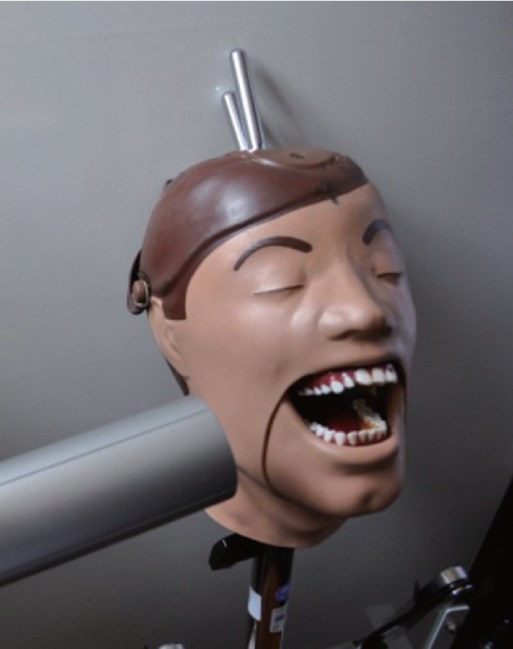
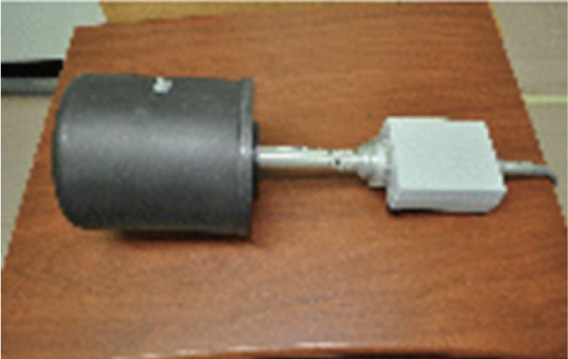
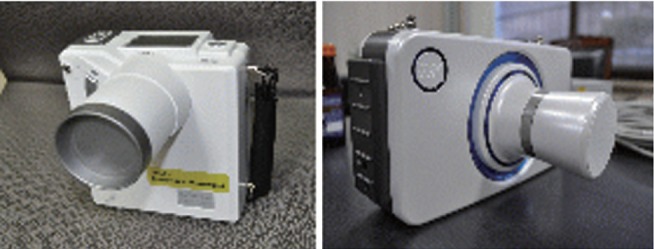

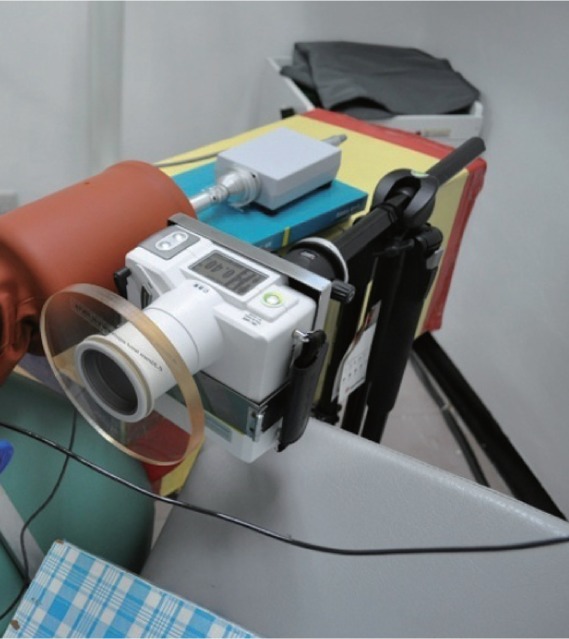


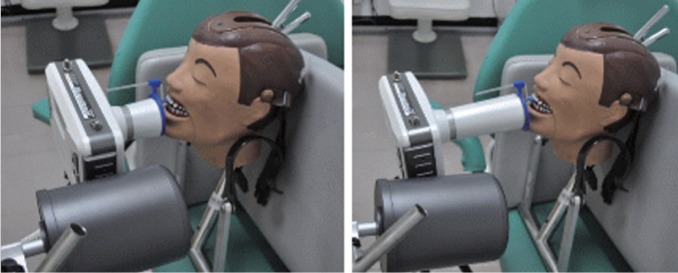
Figure 1
Figure 2
Figure 3
Figure 4
Figure 5
Figure 6
Figure 7
Figure 8
Operator's radiation dose during the exposure of lower teeth with and without the backscatter shield

chest level, 130 cm height from floor; waist level, 70 cm height from floor.
*dose in µR means the leakage and scattered radiation dose and standard deviation measured by an 1,800 cc ionizing chamber.
Operator's radiation dose at the hand level during the exposure of lower teeth with and without the lead gloves

anterior teeth, lower anterior periapical radiography; posterior teeth, lower posterior periapical radiography.
*dose in µR means the average leakage and scattered radiation dose and standard deviation measured by an 1,800 cc ionizing chamber.
Operator's radiation dose at the hand level during the exposure of the lower teeth using 6 cm and 14 cm length cone

anterior teeth, lower anterior periapical radiography; posterior teeth, lower posterior periapical radiography.
*dose in µR means the average leakage and scattered radiation dose and standard deviation measured by 1,800 cc ionizing chamber.
chest level, 130 cm height from floor; waist level, 70 cm height from floor. *dose in µR means the leakage and scattered radiation dose and standard deviation measured by an 1,800 cc ionizing chamber.
anterior teeth, lower anterior periapical radiography; posterior teeth, lower posterior periapical radiography. *dose in µR means the average leakage and scattered radiation dose and standard deviation measured by an 1,800 cc ionizing chamber.
anterior teeth, lower anterior periapical radiography; posterior teeth, lower posterior periapical radiography. *dose in µR means the average leakage and scattered radiation dose and standard deviation measured by 1,800 cc ionizing chamber.

 KACD
KACD




 ePub Link
ePub Link Cite
Cite

